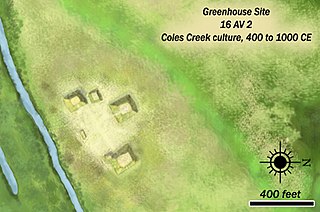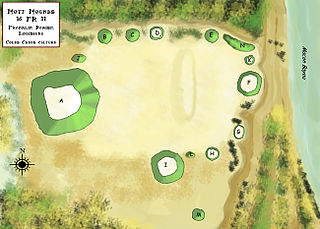
Coles Creek culture is a Late Woodland archaeological culture in the Lower Mississippi valley in the Southeastern Woodlands. It followed the Troyville culture. The period marks a significant change in the cultural history of the area. Population increased dramatically and there is strong evidence of a growing cultural and political complexity, especially by the end of the Coles Creek sequence. Although many of the classic traits of chiefdom societies are not yet manifested, by 1000 CE the formation of simple elite polities had begun. Coles Creek sites are found in Arkansas, Louisiana, and Mississippi. It is considered ancestral to the Plaquemine culture.

The Plaquemine culture was an archaeological culture centered on the Lower Mississippi River valley. It had a deep history in the area stretching back through the earlier Coles Creek and Troyville cultures to the Marksville culture. The Natchez and related Taensa peoples were their historic period descendants. The type site for the culture is the Medora site in Louisiana; while other examples include the Anna, Emerald, Holly Bluff, and Winterville sites in Mississippi.
The Aden site is an archaeological site that is the type site for the Aden phase of Lower Yazoo Basin Coles Creek culture chronology. It corresponds to Middle Coles Creek, chronologically between the Bayland phase and Kings Crossing phase.

Frogmore Mound Site is an archaeological site of the Late Coles Creek culture in Concordia Parish, Louisiana. The site is located 7 miles (11 km) west of Ferriday on US 84. It was added to the National Register of Historic Places on July 28, 2004.
Filhiol Mound Site is an archaeological site of the Coles Creek culture in Ouachita Parish, Louisiana on a natural levee of the Ouachita River.
Balmoral Mounds is an archaeological site of the Coles Creek culture in Tensas Parish, Louisiana. The site has components located both on the east and west sides of US 65 near Bayou Rousset.

Peck Mounds is an archaeological site of the Late Troyville-Early Coles Creek culture in Catahoula Parish, Louisiana.
The Ghost site, or Ghost site mounds is an archaeological site in Tensas Parish, Louisiana, with an early to middle Coles Creek culture component and a Late Coles Creek to Plaquemine culture component.

Fitzhugh Mounds is an archaeological site in Madison Parish, Louisiana from the Plaquemine\Mississippian period dating to approximately 1200–1541 CE. It is the type site for the Fitzhugh Phase(1350-1500) of the Tensas Basin Plaquemine Mississippian chronology.
Scott Place Mounds is an archaeological site in Union Parish, Louisiana from the Late Coles Creek-Early Plaquemine period, dating to approximately 1200 CE. The site is one of the few such sites in north-central Louisiana.
Venable Mound is an archaeological site in Morehouse Parish, Louisiana with a single mound with components from the Troyville, Coles Creek and Plaquemine period.

The Greenhouse site is an archaeological site of the Troyville-Coles Creek culture in Avoyelles Parish, Louisiana.

Deprato Mounds, also known as the Ferriday Mounds, is a multi-mound archaeological site located in Concordia Parish, Louisiana. The site shows occupation from the Troyville period to the Middle Coles Creek period. The largest mound at the site has been dated by radiocarbon analysis and decorated pottery to about 600 CE.

The Raffman site is an archaeological site located in Madison Parish, Louisiana and constructed between 700 and 1200 CE. It has components from the Tchefuncte culture and the Coles Creek culture, whose main period of occupation was during the Balmoral phase of the Tensas Basin and Natchez Bluffs chronology and which was virtually deserted by the end of the Preston phase.

Troyville Earthworks is a Woodland period Native American archaeological site with components dating from 100 BCE to 700 CE during the Baytown to the Troyville-Coles Creek periods. It once had the tallest mound in Louisiana at 82 feet (25 m) in height. It is located in Catahoula Parish, Louisiana in the town of Jonesville. The site is the type site for the Troyville culture of the lower Ouachita and Tensas River valleys. Before it was destroyed for bridge approach fill in 1931, the main mound at Troyville was one of the tallest in North America.
Transylvania Mounds is an archaeological site in East Carroll Parish, Louisiana with components from the Coles Creek (700–1200)CE and Plaquemine/Mississippi periods (1200–1541). It is the type site for the Transylvania Phase of the Tensas Basin Plaquemine Mississippian chronology.
Flowery Mound is an archaeological site in Tensas Parish, Louisiana with components from the Late Coles Creek and Plaquemine-Mississippian culture which dates from approximately 950–1541.
Marsden Mounds is an archaeological site with components from the Poverty Point culture and the Troyville-Coles Creek period. It is located in Richland Parish, Louisiana, near Delhi. It was added to the NRHP on August 4, 2004, as NRIS number 04000803. It is the type site for the Marsden Phase of the Tensas Basin and Natchez Bluff regions local chronology.

The Mott Archaeological Preserve or Mott Mounds Site is an archaeological site in Franklin Parish, Louisiana on the west bank of Bayou Macon. It originally had eleven mounds with components from the Marksville, Troyville, Coles Creek, and Plaquemine periods. It was at one time one of the largest mound centers in the Southeast and has one of the largest mounds in Louisiana with a base which cover more than two acres. It was purchased by the Archaeological Conservancy in 2002. and is now used for research and educational purposes.

Bayou Grande Cheniere Mounds is an archaeological site in Plaquemines Parish near the southeast corner of Louisiana. Built by the Coastal Coles Creek culture, it was inhabited from 875 to 1200 CE, from the Early Coles Creek period to the Coles Creek/Plaquemine period.












